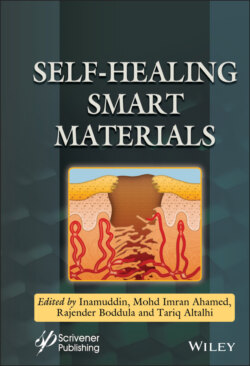Читать книгу Self-Healing Smart Materials - Группа авторов - Страница 37
3.3.2 Styrene Butadiene Rubber (SBR)
ОглавлениеStyrene butadiene rubber is the most used system among the synthetic rubbers. Due to the huge amount of scrap from tires, some researchers focused its interest on the self-healing behavior, which will allow to increases the time of use and the development of high performance smart tires.
Hernandez Santana et al. analyzed the self-healing behavior in SBR compounds containing ground tire rubber (GTR) particles and the coupling agent bis[3-(trietoxysilyl)propyl] tetrasulfide (TESP) [50]. Due to healing process requires chain mobility, authors prepared samples varying the accelerant/sulfur ratio (A/S) in order to evaluate the influence of the density and type of crosslinks: mono, di and polysulfides [51]. The sulfur amount was fixed in 0.7 phr.
The healing efficiency was evaluated through tensile tests: once the test was performed, the two pieces were repositioned together at 70 °C in a press at 10 bar for 7 h. Afterwards, the sample was tested again and the obtained results are shown in Figure 3.12. It was observed that systems with the lowest tensile strength exhibit the higher healing efficiency, corresponding to the ratios A/S = 0.2 and 1. The healing efficiency is attributed to the chain entanglement between the dangling chains on each piece, followed by thermal scission of the di and poly-sulfide bonds, which increases the chain mobility in the broken area. Also was confirmed that the healing efficiency is strongly reduced if the chain mobilization decreases due to a denser crosslinking network or by the use of reinforcement particles.
Araujo-Morera et al. [52] incorporated different amounts of GTR (10, 20 and 30 phr) into an SBR compound. The samples were submitted to 20 stretch cycles up 70 % strain in each cycle. After that, each sample was stored 12 h at room temperature and 12 h at 70 ºC. Through dynamic mechanical analysis (DMA) it was stated that the elastic modulus (E’) diminishes in all the samples once the damage process was applied. That behavior is attributed to the Mullins effect, which is a result of different contributions like: chain scission, breaking of crosslinks, chains disentanglement, filler deagglomeration and softening of the chains that were near the filler surface (bound rubber) [53]. Once the healing protocol was applied, an efficiency of 110 % was obtained in the unfilled sample, which is attributed principally to the entanglement of the dangling chains and to the re-crosslinking of the damaged poly and disulfide crosslinks. Same authors used dielectric spectroscopy to analyze the type of interaction within the rubber composites. Figure 3.13 shows dielectric spectrum of different samples at −25 °C. In the case of the unfilled sample, either in the virgin and damage states, a similar spectrum was obtained, which indicate that the relaxation processes of the sample were exactly the same (Figure 3.13a). After the healing protocol, the spectrum presents a slight widening at high frequencies, indicating a higher number of entanglements promoted by the thermal healing treatment. In the case of the compound with 10 phr of GTR, a particular behavior was observed in Figures 3.13b and c, since the virgin sample indicates the presence of a percolated network that is broken with the cycled deformation, which cannot be recovered after the healing treatment.
Figure 3.12 SBR vulcanized with different values of the ratio accelerant/sulfur (A/S): (a) Tensile strength of pristine and healed samples and (b) Healing efficiency and crosslink density as function of A/S (Reprinted with permission from Hernandez Santana et al. [50]).
Kuang et al. [38] crosslinked furfuryl grafted SBR (SBR-FS) with bismaleimide (M2) via DA reaction at different molar ratios (1/1, 2/1 and 3/1). After the tensile test, the broken samples were pressed and healed at different thermal conditions (70 °C for 30 min, 100 °C for 30 min and 100 °C for 5 h) to induce the healing behavior giving by the reversibility of the DA/ rDA reaction. In addition, author included carbon nanotubes functionalized with furfuryl groups (MWCNT-FA) were included in the compound.
Figure 3.13 Dielectric parameters (e” and s”) as function of frequency at −25 °C: (a) unfilled SBR and (b, c) SBR/10GTR compound (Reprinted from Araujo-Morera et al. [52], open access).
Figure 3.14 (a) Stress–strain curves of SBR-FS/M2 = 3/1 with 5% of MWCNT-FA and (b) Healing efficiency as a function of MWCNT-FA; both for the original sample and healed samples at the specified healing conditions (Adapted with permission from Kuang et al. [38]).
Figure 3.14(a) exhibits the stress–strain curves of samples whose molar ratio was 3/1 of furan/maleimide and 5% of MWCNT-FA. It can be observed that the stress–strain curves with the 3 different conditions after the healing process are overlapped. Moreover, the healing efficiency increases with temperature and time during which the temperature is applied. In Figure 3.14(b) is observed that a small addition of 1 phr MWCNT reduces the healing efficiency.
